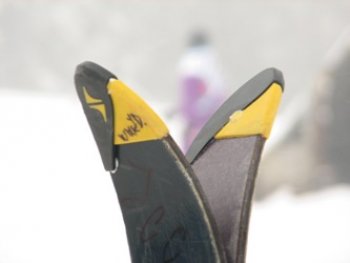This page was created to provide general information on tuning & waxing your skis. There are times when this MUST be done by a professional. It’s a good idea to have your equipment inspected & serviced by a qualified technician at least occasionally. However, for those do-it-yourselfers out there…have at it!
Edges and Waxing:
Your skis need to be in top condition for top performance. This includes a base that’s flat and true and wax that’s matched to the present snow conditions. If you only use your skis a few times a season this will be less important, and you can just prepare your skis knowing that a good tuning and waxing NEVER hurts.
If you ski often, you should consider that you will need to care for your skis every one or two weeks. This includes sharpening the edges and re-waxing the bottoms. You may need to re-wax your skis every 4-6 outings. For avid skiers even $10 hot wax jobs can get expensive.
For the price of a few $4 bars of ski wax, a second-hand electric clothes iron, and a couple of inexpensive files, you can save hundreds of dollars over the life of your skis by learning to do your own skis. It’s not all that hard and as with anything…trial and error…and practice makes perfect!
Tuning Your Edges:
Your skis work best when their edges are sharp. (Sharp enough to cut yourself on.) Any time you feel the urge to hot wax your skis, check the edges. It you check and fine-tune you edges every time you wax, you will find that your edges will last longer.
First, you will need a vice. You can purchase this for about $100 at any well equipped ski repair shop or you can make your own. (You just need something to hold the ski firmly).
To tune your edges, you will need, at minimum, a good fine metal file. Your will need to file the steel edges horizontally (flat across the base) and vertically (at 90 degrees to the base).
A regular flat file can be used for the horizontal filing with very little difficulty. Holding the file at right angles to the base is difficult. Most people successfully use an edge file which has a metal foot plate that runs along the base of the ski and holds a flat file at the necessary 90 degrees. It makes filing a snap! Edge sharpeners are priced at about $25 to $30.
Before running the flat file along the base of your ski, wrap it with some paper so that the file doesn’t come into contact with the plastic base of your skis. Most skiers like to have their edges set not quite a 0-degrees, but rather prefer a 1/2 to 1-degree deviation from the base. Slalom racers set their back as much as 4-degrees.
Run the file carefully along one of the ski’s edges. Try to remove any raised nicks. When the first edge is smooth, begin working on the opposite edge. Once the edges are finished, you can start with the 90-degree edges. Again, remove any raised nicks. Work slowly until both edges are sharp. It’s really a good idea to where some decent work gloves doing this!
.jpg) Waxing:
Waxing:
There is no perfect wax or means of waxing for every snow condition. Snow is certainly not an easy substance to categorize. From the skier’s standpoint, there are basically three kinds of snow:
Powder Snow – Newly formed snow crystals have sharp points which penetrate into the ski’s wax layer and base.
Old Snow – As snow ages, its crystals lose their sharp points and become rounded. Old snow looks grainy. It’s no longer in its crystalline form and can be moist, water logged, or frozen. It causes less friction on your skis.
Moist Snow – Moist snow has already been partially melted. As the temperature drops, it forms ice spheres. It is least aggressive for wax and ski bases.
Matching wax to the condition of the snow isn’t a perfect science…but gets easier with practice and consistent care.
Depending on the hardness of the snow and the hardness of your wax, you can optimize between maintaining a proper layer of water underneath your skis and the friction caused by the snow crystals digging into the wax. Welcome to the art of wax preparation.
The snow should only be a little harder than your wax. If the wax is too soft, the crystals will penetrate the wax layer and form ice patches causing friction. If the wax is too hard, the ice crystals won’t penetrate the wax, break off, melt, and form the necessary water layer.
What does all this mean? To ski racers, a lot. To the rest of us…not much! Just pick your wax by best-guess work based on the snow’s temperature. Most wax systems use three colors, some use more. Generally, the warmer (yellow and red) colors are for warmer temperatures and the colder colors (green and blue) for colder snow temperatures.
Hot waxing:
Assuming your edges are sharp and your ski bases are good, and you have already figured out the mix of wax you want, it’s time to hot wax your skis. You should always work at room temperature. Bring your skis inside overnight to let them warm up and dry off.
You will also need something to melt and smooth the wax. An old iron is great for this…(preferably one without steam holes in the bottom).
You will need a wax scraper. There are small pieces of acrylic plastic that retail for about $6 to $10 that make this job a lot easier!
Clamp your ski in your vice with the base up. It should be as level as possible.
Set your iron to just above Warm. It shouldn’t be any hotter than 120 C. If the wax starts to smoke, your iron’s too hot. While the iron is heating up, scrape off any old wax using your wax scraper.
Holding the iron with its point facing down, hold your wax bar against the iron’s sole plate.
(If your are mixing waxes, you should melt both bars of wax at the same time.) AS the wax melts, move your iron so that you end up with two thin lines of wax running along the length of the ski. If your skis have a middle groove, don’t let the wax drip into the groove.
After the wax has been evenly dripped onto the ski base, run the iron up and down the ski to re-melt and spread out the wax. Work on spreading a thin layer of wax over the entire base of the ski.
The iron should glide smoothly along the entire length of the ski. If it doesn’t, you may need to add a bit more wax.
Take your time and attempt to get the smoothest layer of wax you can. Try to keep from creating any ridges in your wax layer.
When you are finished both skis, allow them to cool without touching each other or anything else. Allow the wax to cool and set overnight.
The next day, scrape off any excess wax after the wax has had time to cool down.
Then placing each ski back in your vice, scrape the excess wax with the wax scraper. Some people say to scrape it right back down to the base. Others say to leave a thin layer. Since you’ve gone to this trouble…we recommend leaving about the thickness of a business card.
Now go out and test those babies!
Simple base repairs:
If you ski with any regularity your ski bases are bound to be less-than-perfect. Conditions aren’t ALWAYS perfect…and thin snow sometimes reveals rocks…and rocks and ski bases don’t like each other!
You can repair small gouges in the base of your skis using a P-tex candle. You will need to clean out the gouge a much as possible and remove any wax build up in it. Light the P-tex candle with a match and wait for the substance to begin melting.
Once up to temperature, the P-tex candle begins to burn itself and melts. This material can be a bit tricky to deal with…just use caution and it’s a good idea to cover all exposed areas of the skis except what you are repairing.
When you’ve finished with the candle you will be left with globs of plastic which you will have to smooth down to a nice finish. The best way to do this is with a flat piece of metal and scrape off the excess. Work from the middle and take off a little bit at a time otherwise you may rip the new material out.
When to take your skis to the shop:
If your skis are in good repair, your edges should be true to the bottoms of your skis and your bottoms perfectly flat. If your bases of your skis become concave (hollow) or convex (bulge out), you will need to have them professionally ground. It costs about $40 to have this done and is well worth it. Also, no matter how well you care for your own skis, sooner or later the edges will be too far gone for simple sharpening. Stone grinding is in order and should be done at the ski repair shop.

